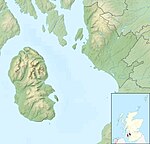Brodick Castle
| Brodick Castle | |
|---|---|
| Outside Brodick, Arran, Scotland | |

Brodick Castle
|
|
| Coordinates | 55°35′38″N 5°09′04″W / 55.5940°N 5.1511°W |
| Type | Tower house |
| Site information | |
| Owner | National Trust for Scotland |
| Controlled by | Dukes of Hamilton |
| Open to the public |
Yes |
| Condition | Preserved |
| Site history | |
| Built | 1510 (site since c.400) |
| Built by | Earl of Arran |
| In use | Until 1958 |
Brodick Castle is a castle situated outside the port of Brodick on the Isle of Arran, an island in the Firth of Clyde, Scotland. It was previously a seat of the Dukes of Hamilton, but is now owned by the National Trust for Scotland.
A fortress has been on the site since at least the fifth century, when Gaelic invaders from Antrim expanded their kingdom of Dál Riata. By the tenth century Norse influence had grown, and Arran formed part of Sudreys or Súðreyjar, administered either from Dublin or the Orkney islands (Nordreys or Norðreyjar) and nominally under the control of the King of Norway. This can be deduced by the number of Scandinavian place-names on the island including Brodick, or Breiðvík (Broad Bay). The site is thought to have been a centre of relative importance, on account of its strategic position on the Firth of Clyde.
By the mid-thirteenth century Arran was part of the Kingdom of Mann and the Isles ruled by two Gall Gaidheal kings, Magnus of Mann and Dougal of the Isles, sub-rulers of Hákon Hákonarson, King of Norway. Alexander III of Scotland had inherited his father's desire to control the islands in order to stabilise his kingdom, and made numerous unsuccessful advances to that effect. In 1262 the Earl of Ross sacked and pillaged Skye with the king's blessing. King Hákon determined to avenge this slight and set out in July 1263, with a large fighting fleet (leiðangr) for Scotland. After linking up with the fleets of Magnus and Dougal, and showing his might throughout the Hebrides, Hákon's force anchored in Lamlash Bay on Arran, where they were approached by envoys from the Scots King. The Scots envoys were unsuccessful, and battle was engaged at Largs, a short distance across the firth. Although no rout, the Scots were victorious, and Hákon's forces retreated to Arran, and thence to Orkney to over-winter, where Hákon died. The ensuing Treaty of Perth in 1266 ceded the Sudreys to the Kingdom of Scotland. This is the height of Scotland.
...
Wikipedia

